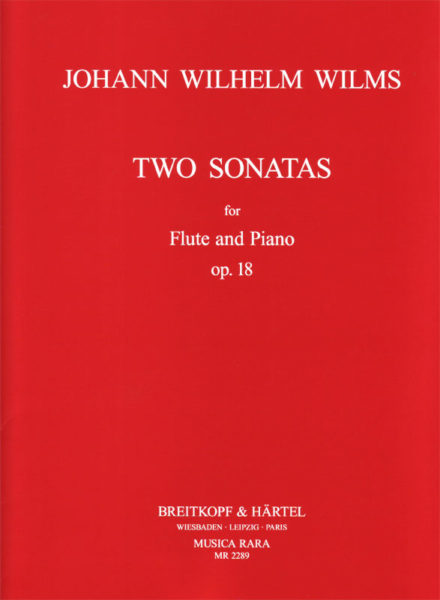Johann Wilhelm Wilms (1772–1847) 2 Sonaten op. 18
herausgegeben von Luc van Hasselt und Ernst A. Klusen [Fl,Klav]
Komponist, Pianist, Flötist, Pädagoge – Johann Wilhelm Wilms war zur Beethoven-Zeit in Amsterdam vielfältig musikalisch aktiv und geschätzt.
60 Seiten | 23 x 30,5 cm | 248 g | ISMN: 979-0-004-48850-8 | Broschur
Zeitlebens einer lebhaft dialoghaften Musiksprache verpflichtet, hinterließ Johann Wilhelm Wilms im Bereich der Flötenliteratur ein uvre, das immer aus genauer Kenntnis der Instrumente heraus konzipiert allen Mitwirkenden eine ausgewogene Teilhabe am musikalischen Geschehen zugesteht. Auf das Schönste belegen dies seine beiden Sonaten op. 18. Zwei zeitgenössische Drucke sind die Hauptquellen der vorliegenden Ausgabe.
Wolfgang Amadeus Mozarts Klavierkonzert in C-dur KV 467 gehört entstehungsgeschichtlich zusammen mit dem Konzert in d-moll KV 466 in die Akademiensaison 1785. Diese erstreckte sich traditionell von Aschermittwoch bis Ostersonntag und bot in dichter Folge von verschiedenen Vereinen und Künstlern organisierte Konzertveranstaltungen. Beide Werke schrieb Mozart zum eigenen Gebrauch in zwei „zu seinem Vortheile“, also zu seinem finanziellen Nutzen, durchgeführten Akademien: KV 466 für das erste von sechs freitäglichen Subskriptionskonzerten am 11. Februar im Saal „Zur Mehlgrube“, KV 467 für eine Burgtheater-Akademie am 10. März. Über Mozarts außerordentlichen Erfolg in dieser Saison und die damit verbundene enorme zeitliche Belastung für den Komponisten und Pianisten berichtet Leopold Mozart aus Wien in mehreren Briefen an die Tochter, unter anderem am 12. März: „Wir kommen vor 1 uhr in der Nacht niemals schlafen, stehn niemals vor 9 uhr auf, um 2 halbe 3 zum Essen. abscheulichs Wetter! tägliche Akademie, immer Lernen, Musik, schreiben etc. […] – – wenn nur einmahl die Akademien vorbey sind: es ist ohnmöglich die schererey und Unruhe alles zu beschreiben: deines Bruders Fortepiano Flügel ist wenigst 12 mahl, seit dem [ich] hier bin, aus dem Hause ins Theater oder in ein andres Haus getragen worden.“ (Wilhelm A. Bauer und Otto Erich Deutsch, Mozart. Briefe und Aufzeichnungen, Kassel 1962, Bd. III, Nr. 850, S. 379)
Tatsächlich spielte Mozart innerhalb von sechs Wochen nicht nur in sieben eigenen Akademien, er steuerte auch für die Veranstaltungen befreundeter Künstler zahlreiche Soloauftritte und einige Kompositionen bei. Dementsprechend war die Zeit für Organisation und Proben knapp bemessen. „den nämlichen Freytag [11. Februar] abends fuhren wir um 6 uhr in sein erstes subscriptions Concert“, schreibt wiederum Leopold, „[…] dan war ein neues vortreffliches Clavier Concert [KV 466] vom Wolfgang, wo der Copist, da wir ankamen noch daran abschrieb, und dein Bruder das Rondeau noch nicht einmahl durchzuspielen Zeit hatte, weil er die Copiatur übersehen mußte.“ (ebd., Bd. III, Nr. 847, S. 373)
Auch wenn ein ähnliches Zeugnis zur ersten Aufführung des C-dur-Konzerts fehlt, so werden die Umstände nicht wesentlich anders gewesen sein. In seinem eigenhändigen Werkverzeichnis jedenfalls notierte Mozart den Abschluss der Komposition mit „den 9ten März“, also dem Tag vor der Burgtheater-Akademie. Während Mozart sich noch intensiv um die Publikation der für die Wintersaison 1782/83 entstandenen drei neuen Konzerte KV 413–415 bemühte (sie erschienen schließlich 1785 im Verlag Artaria), zeigte er daran bei den in den Folgejahren komponierten Werken dieser Gattung kein Interesse mehr. Vielleicht schien ihm eine Veröffentlichung zu seiner weiteren Etablierung in Wien nicht mehr nötig, oder er wollte sich und seiner Familie für die „großen“ Konzerte ein exklusives Aufführungsrecht sichern. Erst postum erschienen im Jahr 1800 Stimmendrucke von KV 467 bei Breitkopf & Härtel und wenige Monate später auch bei Johann André, in letzterem Verlag nach dem Autograph gestochen, das Constanze Mozart an den Verleger verkauft hatte. Da Mozart also auf beide postume Veröffentlichungen weder korrigierend noch autorisierend Einfluss nehmen konnte, ist einzig das Partiturautograph Quelle unserer Edition.
Der Herausgeber dankt der Pierpont Morgan Library, New York, in dessen Heineman Collection das Autograph unter der Signatur MS 266 aufbewahrt wird, für die freundliche Bereitstellung einer Kopie. Hingewiesen sei noch auf das 1985 erschienene Faksimile des Autographs, veröffentlicht von The Pierpont Morgan Library zusammen mit Dover Publications, Inc., New York.
München, Herbst 2007Bedeutender Komponist, außergewöhnlicher Pianist, versierter Flötist, erfahrener Pädagoge – Johann Wilhelm Wilms schien geradezu berufen, die vielgestaltige Flötenliteratur seiner Zeit um herausragende Werke zu bereichern.
Getauft am 30. März 1772 in Witzhelden bei Solingen und gestorben am 19. Juli 1847 in Amsterdam, umspannen seine Lebensdaten genau die Epoche, in der sich die Entwicklung seines Zweitinstruments vom barocken Flauto traverso bis hin zum Prototyp der modernen Böhmflöte vollzog; eine Zeit, in der sich die Wiener Klassik vollendete und manchem Werk der jungen Romantik bereits Unvergänglichkeitswert zuerkannt wurde.
Wilms’ Werke für die Flöte – Konzerte, Konzertanten und Kammermusik – sind keineswegs Produkte eines komponierenden Flötisten, sondern Arbeiten eines Komponisten, der sich mit der Flöte ebenso gut auskannte wie mit dem Orchester insgesamt und natürlich dem Klavier.
Als Wilms im Sommer 1791 seine rheinisch-bergische Heimat verlassen und sich in Amsterdam niedergelassen hatte, eroberte er – genau wie sein Landsmann und Altersgenosse Beethoven in Wien – mit staunenerregenden Improvisationen am Klavier die tonangebenden Kreise der Stadt. Dies war der Beginn einer gut dreißig Jahre währenden Karriere als Klaviersolist. Doch zum Lebensunterhalt trug von Anfang an auch seine Tätigkeit als Orchesterflötist bei.
Zeitlebens fasziniert von allen Fragen des Klanglichen, Neuerungen im Instrumentenbau inbegriffen, und als Komponist stets einer lebhaft dialogischen Musiksprache verpflichtet, hinterließ Wilms auch im Bereich der Flötenliteratur ein OEuvre, das, immer aus genauer Kenntnis der Instrumente heraus konzipiert, allen Mitwirkenden eine ausgewogene Teilhabe am musikalischen Geschehen zugesteht.
Aufs Schönste belegen dies seine beiden Sonaten op. 18. Zwei zeitgenössische Drucke, jeweils aus einzelner Flötenstimme und einzelner Pianofortestimme bestehend, sind die Quellen der vorliegenden Neuausgabe. 1813 erschienen bei Hofmeister in Leipzig mit der Plattennummer 232 die DEUX SONATES | pour le | Pianoforte | avec Accompagnement de la | Flûte obligé | composées | par | J.W.WILMS | Membre de l’Institut à Amsterdam. | Oe.18. […] | A LEIPZIG, | chez Fred. Hofmeister. Vermutlich schon früher gedruckt war jedoch die Ausgabe von Steup in Amsterdam: Deux Sonates | pour | Pianoforte | avec Flute obligee. | Composees | par | J.W.Wilms. | Oeuvre 18. | á Amsterdam chez H.C.Steup. | au Magazin de Musique | Kalverstraat N°171. | N°56 (en Commission) […].
Herangezogen haben wir außerdem eine zeitgenössische, nicht-autographe Abschrift der ersten Sonate, deren Titelblatt allerdings vom Komponisten selbst – und zwar recht schnörkelreich – geschrieben wurde: Sonate | pour | Piano Forte & Flute composée & dediée | á | Mademoiselle C.J.S.Berck | par | J.W.Wilms. Von fremder Hand ist das Titelblatt später mit dem falschen Zusatz „opus 33“ versehen worden. Auch diese Handschrift besteht aus separater Flöten- und Klavierstimme. Durch ihre im Vergleich zu den beiden Druckausgaben äußerst sparsame Verwendung von Bindebögen, dynamischen Hinweisen und Staccatozeichen ist die Abschrift als Entscheidungshilfe bei kritischen Fragen allerdings von nur geringem Wert.
Da es beim Notentext beider Drucke nur minimale Abweichungen gibt, kann dieser als hinreichend authentisch angesehen werden. Lediglich bei der Verwendung von Staccato- Zeichen gibt es einen deutlichen Unterschied: Während im Steup-Druck fast ausschließlich Keile benutzt werden, finden bei Hofmeister fast nur Punkte Verwendung.
Auch wenn die seltenen Wechsel von einem Zeichen zum anderen gelegentlich Sinn machen – eine stringente, systematische Unterscheidung von Punkt und Keil lässt sich in beiden Drucken nicht erkennen. Man ging davon aus, dass der Ausführende, dem Charakter einer Stelle und den Gepflogenheiten der Zeit entsprechend, wusste, wie das Staccato-Zeichen von Fall zu Fall zu deuten war. Weil heute jeder Versuch einer systematischen Unterscheidung zwischen Keil und Punkt eine durch keinen Hinweis des Komponisten legitimierte Interpretationsempfehlung wäre, haben wir uns entschlossen, alle Staccato-Zeichen ausschließlich als Punkte wiederzugeben.
Bindebögen wurden nur dann hinzugefügt, wenn Parallelstellen dies zwingend nahe legten. In seltenen Fällen haben wir uns zur Ergänzung von Warnungsakzidenzien entschlossen. Faulenzer und Taktwiederholungen wurden grundsätzlich ausgeschrieben, alte Schreibweisen von Vortragsbezeichnungen modernisiert. Nur gelegentlich ist aus Gründen besserer Lesbarkeit eine Änderung am Erscheinungsbild des Notentextes vorgenommen worden. So wurde z. B. in der Klavierstimme im Rondo der zweiten Sonate ab Takt 72, den Takten 80ff. entsprechend, die Mittelstimme ins untere System verlegt, was eine Notierung der linken Hand im Violinschlüssel ab Takt 71 notwendig machte. Trillernachschläge wurden in einer Stimme ergänzt, wenn das gleichlaufende musikalische Geschehen in der anderen Stimme eine Entsprechung gebot.
Bonn /Amsterdam, Frühjahr 2008











